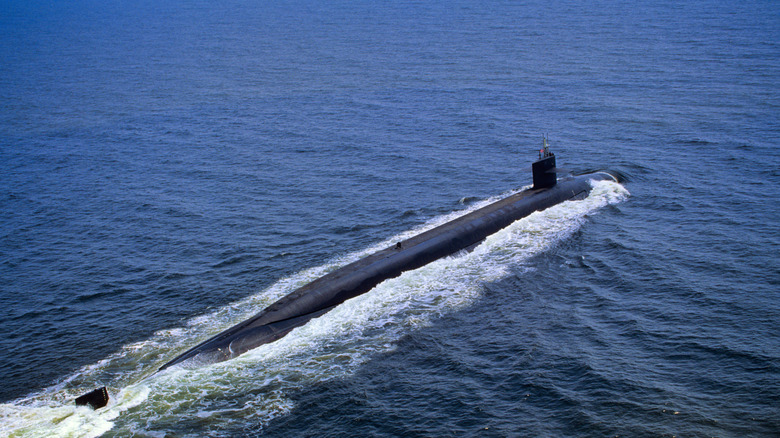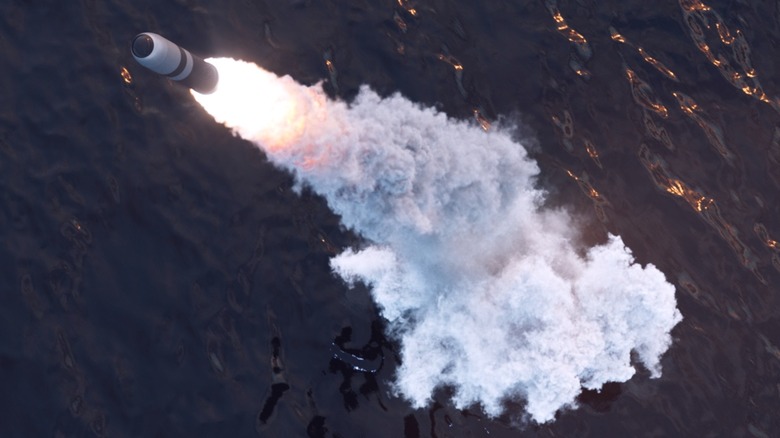Can Submarines Launch Missiles While Submerged? A Look At How Their Weapons Systems Work
For most of the submarines' military history, launching a missile of any kind was out of the question. Subs were primarily used throughout much of the 20th century as covert anti-ship vessels capable of launching torpedoes at enemy ships. Things began to change with the advent of nuclear power, and modern submarines are quite different. The subs currently creeping along the depths of the world's oceans are powerful missile platforms capable of launching various ordnances.
Modern subs like the United States Navy's Ohio-class nuclear ballistic missile submarines are designed to fire off massive submarine-launched ballistic missiles (SLBM), and plenty of people likely know that thanks to movies like "Crimson Tide." What most folks aren't aware of is exactly how these missiles are launched, begging the question, "Can submarines launch missiles while submerged?" The answer to that question is yes, but it's not as simple as pushing a button at any depth and launching any kind of missile — it's a complex process.
When the U.S. first test-fired an SLBM from the USS Cusk (SS-348) in 1947, it did so with modified equipment from the deck on the surface. It took time to develop the technology needed to fire missiles from beneath the waves, but nowadays, shooting off a variety of missile types while submerged isn't only possible; it's the best option for tactical deployment of weapon systems that keep submarines as safe as possible from detection until the last possible moment. Here's what subs can fire and how submarine underwater missile systems work.
Types of missiles fired from submarines
When most people think of SLBMs, they probably picture massive nuclear-armed intercontinental ballistic missiles (ICBMs) featured in nearly every post-apocalyptic nuclear wasteland movie. While they certainly exist, they're hardly the only type of submarine-launched missiles out there. Modern naval operations use them so extensively that submarine-launched missiles have become an integral aspect of naval warfare for decades. Since the U.S. and the USSR (now Russian Federation) haven't used nuclear-armed SLBMs in warfare, they've clearly been launching something else, and there's a variety of options.
The many different types of modern U.S. Navy submarines can fire different types of missiles. Most notably, they can also shoot off submarine-launched cruise missiles (SLCM), so there's a variety of options available, including anti-ship, anti-submarine, and ground-attack missiles. Technically, SLBMs aren't the same thing as ICBMs, but they're closely related with many of the same capabilities. That said, ICMBs are launched from ground-based silos. Regardless, the function is the same: many SLBMs are multi-stage rockets, and the Trident II, which is used by the U.S., has a range of over 4,000 miles.
SLCMs are similar to their naval surface and air-based deployment cousins, and there are nuclear-armed varieties as well. Most nations that operate submarines have the capability to launch missiles of various types, including Russia, China, the U.S., France, the United Kingdom, North Korea, and others. Regardless of the type of missile fired from a submarine, they all operate in much the same manner, and it's probably not how you'd imagine because, despite being fired from underwater, the missiles don't get wet.
How modern military submarines fire their missiles
For SLBMs, the Ohio-class, which is being replaced by the Columbia-class, carries UGM-133A Trident II D5 missiles. These SLBMs are launched from vertical tubes within the submarines. The launch system incorporates compressed gases, which fully encompass the missile. An explosive charge flash-vaporizes water into steam, which pushes the missile out of its tube and into the water. The gas bubble keeps it from getting wet as it ascends, and once it breaks the surface, the onboard systems ignite the rocket engine.
The missile appears to hang in the air for a moment as this happens, but as soon as it's needed, the booster ignites, sending the missile off toward the sky. The first stage burns for around 65 seconds, taking it up until the second stage brings it to around 600 miles above sea level. Other nations' SLBMs function in very much the same way, as do SLCMs, which are similarly fired from vertical launch tubes built within the submarine's hull. It's also possible to launch SLCMs, like the Tomahawk cruise missile, from modified torpedo tubes.
The Navy's three Seawolf-class boats have this capability. Whether they're fired from torpedo tubes or purpose-built vertical launch tubes like on Virginia-class subs, the process is the same. Each missile is ejected via high-pressure steam, propelling it into the water and toward the surface. They're encompassed by a bubble of gas to keep them dry, and once they break the surface, SLCMs fire off their boosters and take to the sky.


